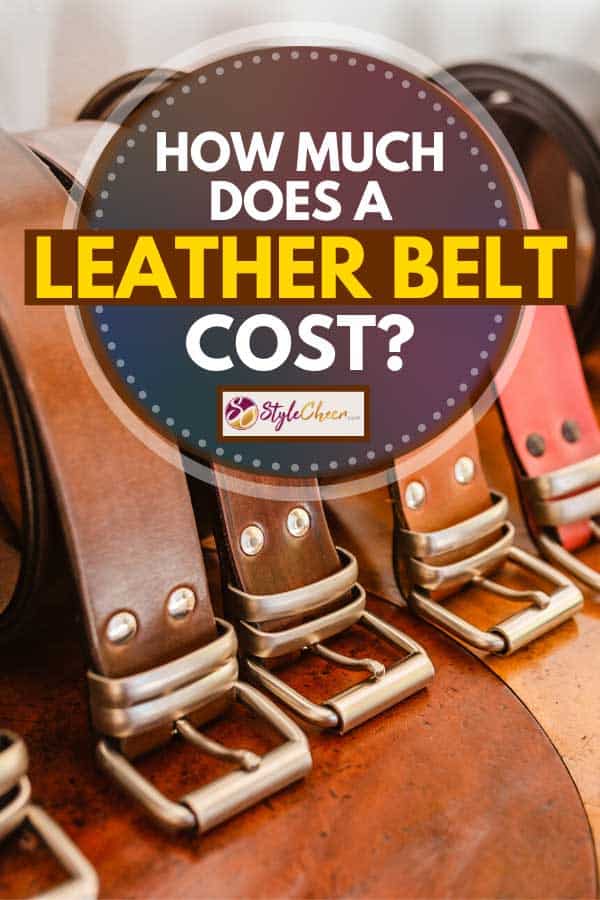Are you on the lookout for a new leather belt? Maybe your favorite leather belt that has been your go-to choice for years finally reached the point of no return. Or, maybe you are looking for another fashionable item to add to your closet. Either way, you are probably wondering what the typical price ranges are.
The expected price for a 100% leather belt varies greatly. The lower-priced belts tend to cost around $15 to $25. The mid-priced leather belts usually cost $40 to $50. The higher-priced belts cost easily cost $100 and up, especially if you want to buy a designer belt. 
This article may include affiliate links and elements that were carefully created by our team using advanced ai to help you envision the best style advice.
We know this is a considerable price range, so you probably still have a lot of questions related to the pricing. Lucky for you, we looked into this and much more about leather belts, so you don't have to. Continue reading to find out more helpful information over this topic.
What is the Best Leather For Belts?
All leather comes from animal skin, but there are different types. The different kinds of leather go through various processes that affect the material quality and final product prices. The huge price range of leather belts is partly due to the type of leather that is used to make the belt you want to buy.
If you want to buy the highest quality leather belt and are not too concerned with finding a low price, you should buy a belt made from full-grain leather. Full-grain leather is the best leather for belts. It comes from the upper layer of the hide and is exceptionally durable and strong. A belt made from this kind of leather is sure to last for years and have minimal stretching.
Here are a few options of full-grain leather belts:
Click here to view it on Amazon.
Click here to view it on Amazon.
Click here to view it on Amazon.
If you are interested in learning about other types of leather used for belts, and how to care for them, check out this blog post.
What is the Cheapest Leather For Belts?
More affordable leather belt options are commonly made of fiber leather. This is also referred to as "genuine leather." This will almost always be the material used for lower-priced leather belts.
Fiber leather is made out of the unused scraps from other leather products. These recycled pieces are combined with an adhesive and pressed into usable material. This means this kind of material is not 100% leather, but it is still a leather product. The material is a little deceiving to buyers since companies advertise fiber leather products as "genuine leather" even though it is not a 100% leather product. Because of this, these belts are more likely to wear out quicker than other types of leather. However, they are the least expensive option for a leather belt.
Here are a few affordable leather belt options:
Click here to see this belt on Amazon.
Click here to see it on Amazon.
If you are a frequent belt wearer, it may be a better decision to invest in a higher quality leather belt. The initial cost is higher, but you may be saving money over time. If you are not an everyday belt wearer, then these kinds of belts may be all you need.
How Can You Tell if a Leather Belt is Pure?
You may be wondering how to figure out if the belt you want to buy is pure. Sometimes looks can be deceiving, and you don't want to get scammed. Here are five ways to tell if a leather belt is actually leather.
Check the Belt Label
Trust your first instinct and read the materials listed on the label. Hopefully, the label will say 100% full-grain leather or something similar. If the label mentions any man-made materials, like polyvinyl chloride (PVC), then it is not pure leather. This is a synthetic substance that is the most common material in vegan leather, "pleather," products.
If there is no label and it is a new item, then it is probably not real leather. If it is a vintage item, it could still be genuine leather.
Use Your Nose
If you have ever smelled real leather, then it is hard to forget its distinct scent. It is a subtle, earthy, organic fragrance. Since high-quality pure leather is tanned with little to no natural chemicals, these raw smells can stay with the product.
Faux leather does not smell like this at all. It smells like plastic and chemicals because that what a synthetic material is made of. If you get any whiff of plastic, then the belt is certainly not pure leather.
If you already have a pure leather product, smell it. This will help you train your nose to recognize real leather. Then when you are out shopping and do a leather scent test, you know you have the correct scent to compare it to.
Waterdrop Test
Leather is porous because it is animal skin. This means it has thousands of small holes in it. Because of this, it will absorb water.
If you drip a tiny water droplet on a discrete section of the belt, it should soak into the material and disappear. If the droplet pools on top and slides off when you move the belt, this indicates the material is not 100% leather. Plastic based synthetic polymers will repel water.
Use Your Hands
Pure leather will not have a uniform texture. It can be smooth, but as you run your fingers across the belt, you should notice some inconsistencies in the surface texture. Fake leather will feel unnaturally smooth and plastic-like because it is plastic-based.
You can also use your hands for a wrinkle test. Take your fingers and pinch a section of the belt. Real leather will wrinkle like skin. Then pull a section of the belt. Real leather will visibly stretch and change shape. If you are pinching and pulling the belt and you feel no change in texture, then it is most likely faux leather.
Pay Attention to the Edges
The edges of pure leather feel rough and unfinished. They also can appear to be slightly lighter in color. The edges of fake leather feel perfectly smooth and tend to be the same color as the front of the belt.
In addition, leather is harder to regulate because it is natural. This means two belts of the same style and brand can have subtle differences. Take two of the same belts and run your hands over the edges at the same time. If you notice slight differences, then it is probably real leather. Synthetic leather will be much more uniform.
How Thick Should My Leather Belt Be?
If you are looking for a decent leather belt, then thickness is a very important factor to take into consideration. Thicker belts tend to cost more, but also tend to last longer.
Leather belts can range from 2 mm to 6 mm thick. The thicker the belt is, the more durable it will be. The thinner the belt is, the more flexible it will be. Because of this, most leather belts are about 3 mm thick. This allows enough movement around your waist while still being able to handle everyday wear and tear.
Is it Possible to Make My Own Leather Belt?
Crafting your own leather belt is a possibility. Buying the needed raw material is much cheaper than spending hundreds of dollars on a designer product. It may sound intimidating to try and make your own belt, but it is more feasible than you think. It could be a great starter project if you are interested in working with leather. Click here for a great guide on making your own leather belt.
Leather belts are a fashion piece that should be in everybody's closet. This staple item goes with so many outfit choices, as well as other leather accessories like ankle bracelets. Check out our blog about black leather anklets. The huge price range of leather belts means everyone can find a belt they can afford. Get out there and find yourself a quality belt!






![Woman washing a shirt with her hand, Remove Tire Marks From Clothes Like a Pro [How to Guide] - 1600x900](https://stylecheer.com/wp-content/uploads/2023/08/shutterstock_305739509-300x169.jpg)

